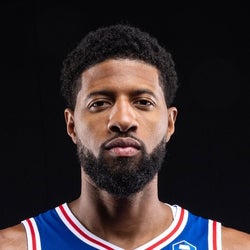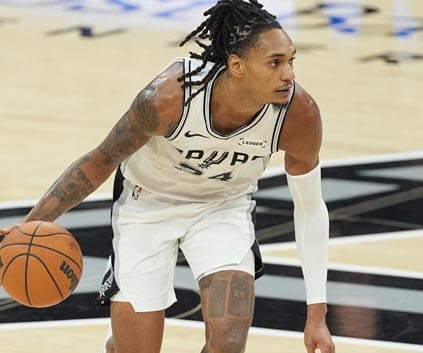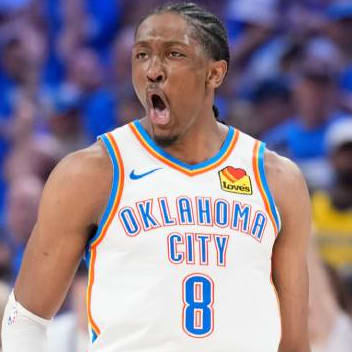2025 Stats
PTS
16.3
REB
5.5
AST
3.4
STL
1.5
BLK
0.5
ROS Projections
2025 Fantasy Outlook
Since leaving Oklahoma City following the 2018-19 campaign, George has played more than 56 regular-season games only once, including 41 appearances last season. The veteran dealt with numerous injuries during the 2024-25 campaign. If that wasn't enough for the oft-injured forward, he needed another surgery this offseason after tweaking his left knee during a workout. While he's expected to be ready for training camp, it'd be malpractice to operate under the assumption that George will be able to handle a full superstar workload to start the 2025-26 campaign, regardless of how well his rehab goes. Fellow superstars Joel Embiid and Tyrese Maxey will likely be in the same boat after missing extended time as well, but Maxey doesn't have the injury history of George or Embiid. With Philadelphia banged up last season, Quentin Grimes and Jared McCain showed flashes of immense potential. They could eat into the overall usage when they get hot, plus rookie No. 3 overall pick VJ Edgecombe will need to be integrated into the offense. That said, George will make over $50 million per year for the next three seasons (player option for 2027-28), so when he's on the court, the 76ers will need all the usage they can get out of him. The injuries have turned George into one of the more polarizing players in fantasy hoops. Over the last five years, he has had a top-10 finish in eight-category leagues and ended outside the top 150 twice. Read Past Outlooks

Good to go vs. OKC
George (knee) is available for Sunday's game against the Thunder.
ANALYSIS
As expected, George will shake off his probable tag due to left knee injury management and suit up in his third straight game. In eight appearances during December, the veteran forward has averaged 17.8 points, 6.0 rebounds, 3.4 assists and 1.1 steals in 30.9 minutes per contest.
As expected, George will shake off his probable tag due to left knee injury management and suit up in his third straight game. In eight appearances during December, the veteran forward has averaged 17.8 points, 6.0 rebounds, 3.4 assists and 1.1 steals in 30.9 minutes per contest.
NBA Per Game Stats
Per Game
Total
Per 36
NBA Per Game Stats
Loading Per Game Stats...
2025 NBA Game Log
2025
2024
2023
2022
2021
2020
2019
2018
2017
2016
2025 NBA Per Game Split Stats
Schedule
By Month
Starting/Off Bench
Days Rest
Vs Opp
By Result
2025 NBA Per Game Split Stats
Loading Split Stats...
Advanced Stats
Loading Advanced Stats...
Stat Review
2025
2024
2023
2022
2021
2020
2019
2018
2017
2016
How does Paul George compare to other players?
This section compares his stats with all players from the previous three seasons (minimum 200 minutes played)*. The bar represents the player's percentile rank. For example, if the bar is halfway across, then the player falls into the 50th percentile for that stat and it would be considered average.
True Shooting %
56.2%
Effective Field Goal %
50.9%
3-Point Attempt Rate
48.8%
Free Throw Rate
28.0%
Offensive Rebound %
1.5%
Defensive Rebound %
20.2%
Total Rebound %
10.6%
Assist %
18.8%
Steal %
2.2%
Block %
1.5%
Turnover %
8.6%
Usage %
24.3%
Fantasy Points Per Game
32.1
Fantasy Points Per Minute
1.2
NBA Historical Fantasy Stats
Historical ADP
Loading Historical ADP...
76ers Depth Chart
Our full team depth charts are reserved for RotoWire subscribers.
Subscribe Now
76ers Rotation: Minutes Breakdown
Loading 76ers Rotation Data...
Average Fantasy Points
Minutes
FanDuel
DraftKings
Yahoo
FantasyDraft
Head2Head
Sorare
Average Fantasy Points are determined when Paul George was active vs. non-active during the season. Click here to view average fantasy points for a different time period.
Loading Average Minutes...
Past Fantasy Outlooks
2024
2023
2022
2021
2020
2019
2018
2017
2016
2015
2014
2013
2012
2011
2010
After spending an injury-riddled five years on the Clippers, George signed a four-year max contract with the 76ers over the summer. George still provided All-Star caliber numbers over the past half-decade, averaging 23.0 points, 6.0 rebounds, 4.5 assists and 1.5 steals in 33.3 minutes. But he appeared in just 263 total games, playing more than 56 games in a season just once (last year; 74 games). That's resulted in fantasy managers trusting him less and less, and he's slipped to a third-round fantasy pick over the past two years. That will likely be the case again this year. One healthy season shouldn't convince anyone that George is now an iron man. He's also entering his age-34 season, around the time we typically start to see more decline in both health and performance. In joining the 76ers, George projects as the team's third option behind Joel Embiid and Tyrese Maxey. Though, with the team's weak bench and Embiid's own injury woes, George should have plenty of opportunities to control the offense and launch shots. Ultimately, managers chasing upside can probably still grab him in the third round, while managers concerned about age and injury risk may want to see if he's still available in the fourth.
More Fantasy News

Probable vs. Oklahoma City
George is probable for Sunday's game against the Thunder due to left knee injury management.
ANALYSIS
Subscribe now to instantly reveal our take on this news.
Subscribe now to instantly reveal our take on this news.

Struggles with shot Friday
George provided 15 points (5-15 FG, 4-9 3Pt, 1-1 FT), 12 rebounds and five assists across 35 minutes during Friday's 109-102 loss to Chicago.
ANALYSIS
Subscribe now to instantly reveal our take on this news.
Subscribe now to instantly reveal our take on this news.

Shows defensive chops vs. Brooklyn
George ended with 19 points (5-14 FG, 2-7 3Pt, 7-8 FT), four rebounds, two assists, two blocks and four steals in 33 minutes during Tuesday's 114-106 loss to the Nets.
ANALYSIS
Subscribe now to instantly reveal our take on this news.
Subscribe now to instantly reveal our take on this news.

Cleared from injury report
George (knee) is off the injury report for Tuesday's game against the Nets.
ANALYSIS
Subscribe now to instantly reveal our take on this news.
Subscribe now to instantly reveal our take on this news.

Resting Saturday
George won't play in Saturday's game against Dallas due to left knee injury management, Adam Aaronson of PhillyVoice.com reports.
ANALYSIS
Subscribe now to instantly reveal our take on this news.
Subscribe now to instantly reveal our take on this news.
Latest Fantasy Rumors

Experienced back tightness
George said he experienced some back tightness during Sunday's loss to the Hawks, according to PHLY Sixers.
ANALYSIS
"But that's going to happen," George said after playing 28 minutes. "That was the most minutes I've played consecutively. It's good. It's nothing to be concerned with. I felt good. I asked for more minutes out there, just how the game was going, how my body was feeling." George didn't have the best night shooting the ball, but he was super active and recorded five steals on the night.
"But that's going to happen," George said after playing 28 minutes. "That was the most minutes I've played consecutively. It's good. It's nothing to be concerned with. I felt good. I asked for more minutes out there, just how the game was going, how my body was feeling." George didn't have the best night shooting the ball, but he was super active and recorded five steals on the night.















